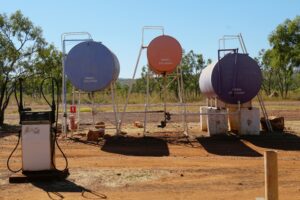
There are a number of different fibres found in plants:
This page will look at some fibre plants.
Source: “Classification and essential parts of fibre crops”, a brochure available at www.dalrrd.gov.za.
Source: www.new-ag.info/09/03/focuson.php [website now defunct]
Source: ARC-IC
See separate page
The stringy inner bark yields a particularly strong and durable fibre that provides things such as rope, thread, strings for musical instruments, and a paperstock tough enough for bank notes.
Source: “Classification and essential parts of fibre crops”, a brochure available at www.dalrrd.gov.za.
See separate page.
The first step in the processing of picked cotton takes place at the ginnery where the fibre, about 37% of the total mass of the cotton, is separated from the seed.
Source: “Classification and essential parts of fibre crops”, a brochure available at www.dalrrd.gov.za.
Source: “Classification and essential parts of fibre crops”, a brochure available at www.dalrrd.gov.za.
There seems to be never-ending list of benefits of the hemp plant. The following products are manufactured from hemp in the USA:
Its perceived relationship with marijuana causes problems. Both come from the plant family Cannabis sativa L., but from different varieties.
The commercial cultivation of hemp in South Africa is prohibited by the following legislation: (i) The Drugs and Drug Trafficking Act, 1992 (Act No 140 of 1992) which describes hemp as dagga. (ii) Medicines and Related Substances Act, 1965 (Act No 101 of 1965) (iii) The Environmental Conservation Act, 1989 (Act No 73 of 1989). Despite this, hemp products are amazingly in high demand, and perhaps for this reason our country does not charge any tariff for hemp imports.
The South African Health Products Regulatory Authority (SAHPRA) regulates the issuing of cannabis licences and the Department of Agriculture, Land Reform and Rural Development (DALRRD) regulates the issuing of hemp licences. In total DALRRD has issued over 371 hemp permits to South African farmers and SAHPRA has issued 102 cannabis licences across the country (Hemp 4 Life, 2024).
The product is mostly grown in South Africa mainly for experimental or research purposes. Producer challenges are covered in the parliamentary committee presentation (27 Feb 2024) at https://pmg.org.za/committee-meeting/38420.
Hemp’s deep roots aerate the soil. After the harvest, its roots and discarded leaves replenish the soil with nutrients. Its early growth and thick canopy choke off weeds, and it breaks disease cycles that reduce the yields of other crops. It can also be grown largely without pesticides and herbicides.
It works well as a rotational crop and soil rehabilitator, soil erosion preventor, cash generator, and organic crop enhancer. The hemp crop is labour intensive, low input, high-yielding, a beneficial companion crop to pineapple and chicory.
The commercial production of this crop has great potential for job creation in rural areas. The development of traditional agriculture based crops such as hemp would help encourage the rural regeneration and small-scale rural industries. Raw materials would be provided to various sectors such as paper, textiles, composites, industrial oils, animal bedding, fibreboards etc.
Sources: Dr Yoseph Beyene, ARC-IC, Rustenburg, CSIR, Diverse International Holdings
“It creates a negative carbon footprint, and is highly versatile. Hempcrete can be used as insulation, flooring, roofing, and even drywall. It is fireproof, waterproof and rot proof provided it is above ground. It is easier to make than concrete, as well as more durable. It is 3x more resistant to earthquakes as compared to regular concrete”.
Find the article “Hempcrete Could Change How We Build Everything” on www. industrytap.com. Hempcrete is similar to concrete but incorporates hemp.
A member of the hibiscus family (Hibiscus cannabinus L), Kenaf is related to okra and cotton.
This source of natural fibre has roots in ancient Africa and Asia where, 4000 years ago, it was cultivated for cordage. Although Kenaf originated in Africa, the modern cultivation is new to Southern Africa. It has been cultivated in the United States and parts of Asia for decades.
Today it is increasingly being viewed world-wide as a sustainable, eco-friendly alternative to petroleum-reliant, synthetic raw materials.
Source: www.kenaf.co.za [website now defunct]
The main production areas have been in the Limpopo Province and KwaZulu-Natal, with annual yields of up to 5000 tons of fibre. The majority of this fibre was processed locally but any surplus was successfully exported to many overseas countries where it was well received because of the high quality of South African grown fibre.
Apart from providing excellent job opportunities, the crop:
The fibre is used in the production of twines and ropes, buffs and carpets, and numerous other minor uses such as the manufacture of dartboards, mattress pads, and crafts. The sisal bowl is most popular for bird nesting purposes, and the attractive sisal poles are widely used in game parks for bomas and hides.
Source: Clive S Henderson, National Sisal Marketing Committee
Refer to the websites and publications listed earlier on this page.